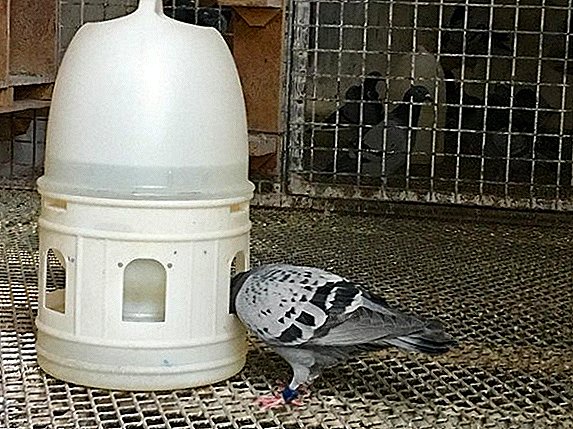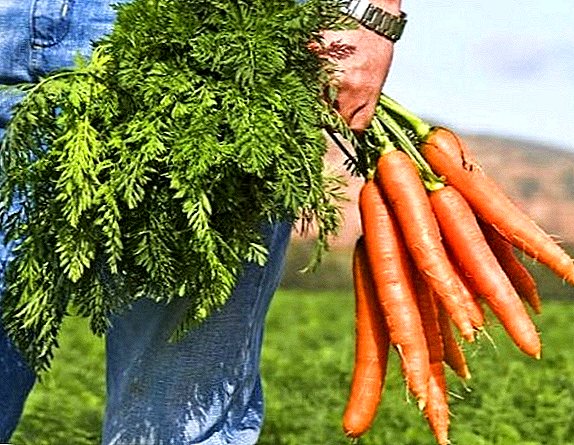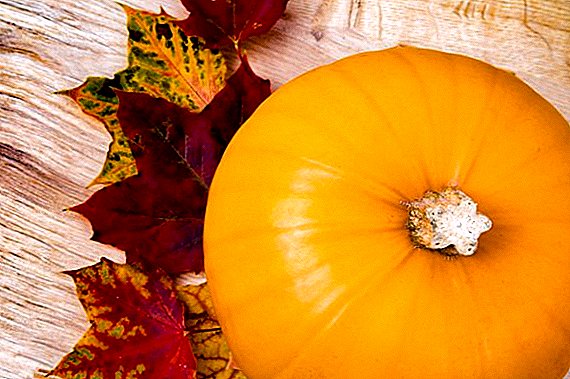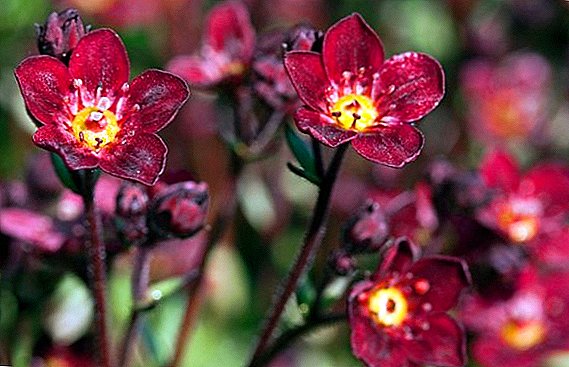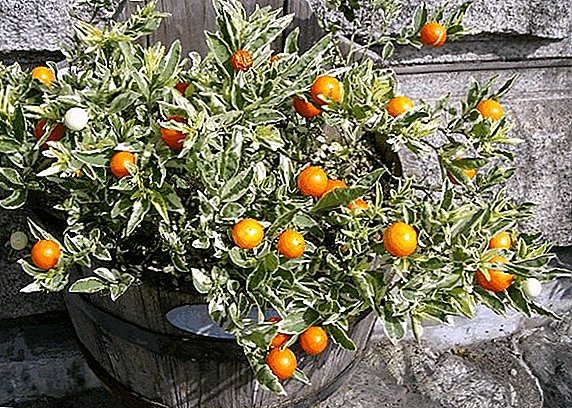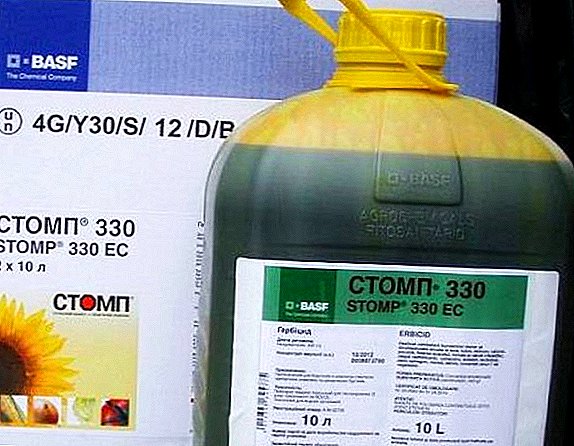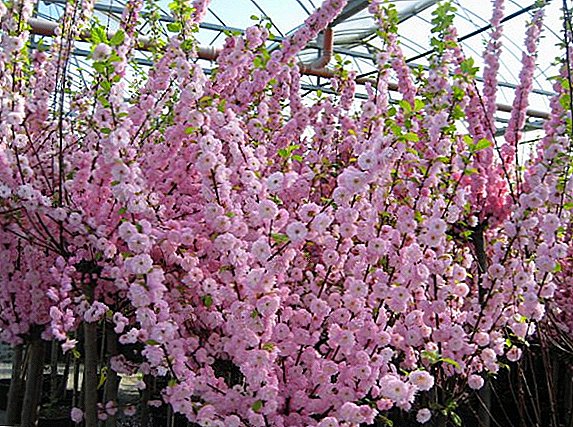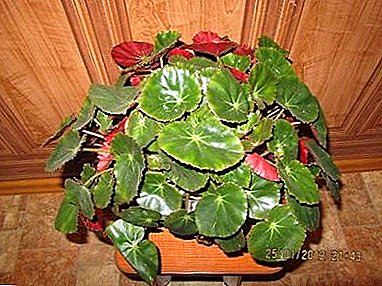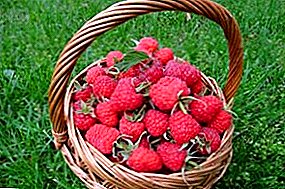 Raspberries are a very popular berry among gardeners that most people love. It is extremely useful. Therefore, the selection of a successful variety of this plant for growing on one's own plot is a guarantee of a future abundant harvest of large and very sweet berries. It is this sort of raspberry "Ispolin", popular in all corners of the country and abroad.
Raspberries are a very popular berry among gardeners that most people love. It is extremely useful. Therefore, the selection of a successful variety of this plant for growing on one's own plot is a guarantee of a future abundant harvest of large and very sweet berries. It is this sort of raspberry "Ispolin", popular in all corners of the country and abroad.
History of creation
Like every plant, raspberry "Giant" has its own history of origin. In 1992, at the Moscow Institute of Horticulture, a medium-sized and winter-hardy raspberry variety with high yields and large fruits was developed.
He was given the "modest" name "Ispolin", but for all the unique properties he received the second name - "The Pride of Russia". As the source, its author, breeder V. Kichin, used the tall, large-fruited variety Stolichny and the short, but prolific Stambov-20 as a donor.
The result was a hybrid that absorbed the best characteristics of the original plants.
Did you know? In Russia, for the first time, a huge raspberry garden was laid by the founder of Moscow, Yuri Dolgoruky. It was so huge that bears came to feast on it.

Characteristics and characteristics of the variety
Raspberry "Ispolin" retained the large size of the Stolichny variety, increased their number thanks to the Shtambovy-20 variety, without losing the taste of the fruit. This is a high-yielding and early-ripening variety.
Bush
In the description of the Raspberry "Giant", first of all, it should be noted that this is a midgrowing variety, the height of the bush reaches 1.5-1.8 m. garden manipulation.
The form of bushes is massive, but compact, not spreading. Plants are blooming with white flowers. New shoots immediately grow quite thick and powerful, and their surface is devoid of wax.  Sheets have a rich green color. After drying, well complement the various tea compositions.
Sheets have a rich green color. After drying, well complement the various tea compositions.
Berries
Bright ruby shiny velvety berries "Ispolina" grow in a heap and reach 4-5 cm in length, and the weight of one berry ranges from 8 to 15 grams.
The average is 8-12 g, although the maximum recorded weight of a single berry is as much as 20 g. The berries are dense, they tolerate transportation well. The form is oblong, cone-shaped.
Small bones do not spoil the taste of jam and mousse. On one branch grows to thirty fruits. A big plus of the variety is that the berries do not fall off, even overriding for 5-7 days, this allows you to keep the maximum amount of harvest and vary the time of collection at your discretion.
The aroma is moderately saturated, pleasant, reminiscent of forest raspberry. The taste of berries - sweet, sweet and sour, not cloying, they themselves have a soft and juicy flesh. 
Ripening and yield
"Ispolin" - remontant raspberry variety, fruiting throughout the season. This variety is of medium ripening time: the first berries ripen in early July, and the last in early September.
Under favorable conditions, the yield is very high and amounts to 20-30 berries from one brush, a young bush can have 3-4 brushes, more overgrown - 5-7. During the season, berries are harvested 5-6 times, from one bush - on average up to 5 kg, and with proper care - up to 9 kg.
Winter hardiness
The variety "Ispolin" is ideal for regions with a harsh climate, it can grow in rather difficult conditions. It perfectly withstands temperatures down to -25 ° C, young shoots become sensitive when the temperature drops to -30 ° C, but minimal shelter solves the problem completely.
Important! Drought ispolina raspberry variety, too, stands firmly.

Use of berries
"Giant" refers to varieties of universal use. They are used to prepare various desserts, jams. Compotes are very fragrant.
Did you know? Raspberry is used in traditional medicine. With colds and high temperatures, it is used as an antipyretic and diaphoretic agent, which gives strength and promotes rapid recovery. Also, raspberry berries are used for cosmetic purposes, prolonging the youthfulness of the skin, whitening and nourishing it.The high content of vitamin C and low glucose content makes these drinks very useful for diabetics. Taking into account the dense pulp of the berries, it is good to cook desserts from them, suggesting the presence of whole fruits, for example, raspberries in their own juice or raspberry jam.
It is believed that because of the low sugar content in the berries, the variety is not suitable for making jam, but it should be noted that the taste qualities often depend on the growing conditions, and too much will not seem too tasty to everyone. 
You will probably be interested in reading about how to make homemade wine and raspberry liqueur.
What to look for when buying seedlings
A good seedling is a small seedling. This is due to the fact that a developed green mass gives off too much moisture into the atmosphere and requires considerable resources to support vital activity.
In turn, the root, injured during transplantation, for some time is simply not able to serve a large plant. Thus, the combination of the factors of the “massive ground part - the injured root” will most likely lead to the exhaustion and fading of the plant.
A suitable seedling has a length of about 40 centimeters and 3-4 developed shoots. The roots should not dry out, for this they are most often dipped in a clay bump, which acts enveloping and prevents moisture loss.
Paper bags with a lump of earth are acceptable, but in a plastic bag tied to the root system, the root may well be rotten or infected with fungal infections.
It is best to buy raspberries in special garden nurseries or in online stores that have proven their reliability. Although large supermarkets cooperate with nurseries, large volumes of purchases do not always guarantee the proper quality of the goods.  You should not buy seedlings in spontaneous markets or folk fairs from private breeders, unless you received a recommendation from a reliable person.
You should not buy seedlings in spontaneous markets or folk fairs from private breeders, unless you received a recommendation from a reliable person.
In such places, sellers are rarely responsible for the quality and varietal purity of seedlings, sometimes simply because they themselves are not very versed in this matter. A sapling grown in a nursery must have an attached tag with the name of the variety and the producer's marker.
Did you know? Under stress, it is recommended to eat raspberries. Copper, which is part of raspberry, helps to cope with the state of depression.
Choosing the right place
There is a direct link between crop quality and growing conditions. The variety "Ispolin" needs good neighborhood. Proper neighborhood is very important both in the garden and in the garden.
It is better not to plant raspberries next to tall crown trees - this will shade the bushes and will have a bad effect on the quality of the crop. Raspberry gets along well with other bushes, such as black and red currants, juniper, wild rose.
The trees are preferably a neighborhood of plums, apples and pears, but cherries will compete with raspberries for nutrients, since the root systems of both plants penetrate the soil to the same depth.  Dill will attract the smell of insect pollinators, and strawberries in tandem with raspberries can make a real breeding ground for diseases, because they have common pests and are subject to the same diseases.
Dill will attract the smell of insect pollinators, and strawberries in tandem with raspberries can make a real breeding ground for diseases, because they have common pests and are subject to the same diseases.
Lighting
For "Ispolina" optimal place with good access to sunlight. It will be enough scattered rays, but in the shade the plant will feel bad and may be prone to diseases of the root system.
It is best to plant a shrub on the east side, so that the plants receive the first rays of the sun.
The soil
Before planting in the first place you need to pay attention to the soil. It should be fertile and fertilized, loose, not clay. Black earth and peaty soils are best suited.
Raspberries will feel better on the dais. In the lowlands, where there are often problems with the retention of moisture, the berries can lose taste.
Site preparation
Seedlings can be planted in open ground throughout the season of active growing season - from April to September. But in practice, the best results are provided by the autumn landing.
Planted in September, the plants have time to firmly root. Before planting seedlings need to prepare the soil. Prepare the site preferably a few days before the planned landing.  Digging, removal of weed plants, fertilization are made in advance so that the soil has time to evenly mix with the introduced substances, soak in them and be saturated with oxygen.
Digging, removal of weed plants, fertilization are made in advance so that the soil has time to evenly mix with the introduced substances, soak in them and be saturated with oxygen.
To this end, take a few kilograms of manure per square meter of land, add 25 g of potassium and 60 g of superphosphate.
Step-by-Step Instruction Landing
Step by step planting occurs as follows:
- in the soil dug up and cleared of weeds, it is necessary to make holes approximately at a distance of half a meter from each other, about 40 x 40 centimeters in size and so deep that the roots are freely placed in the pit and there is space at the bottom for fertilizers;
- the hole is filled with manure or other organic fertilizer by a third;
- the seedling needs to be put in the recess, by leveling its roots and pointing them down;
- the hole is covered by two-thirds of the fertile soil;
- in a hole with a seedling need to pour a few liters of water and let it soak;
- then fill the hole with soil, making a small mound, then slightly compact the soil around the plant so that the root neck is level with the ground;
- the soil around the plant is mulched.
Competent care - the key to a good harvest
Choosing the right place in the garden is half the battle, the second half is competent care. Planting and care are the main components of the productive cultivation of raspberry "Giant". And her care bushes are very loved and always thank for him a good harvest and attractive healthy appearance.
A healthy, strong plant is determined visually: leaf color should be saturated, tissue turgor is not broken. Green flesh should be juicy and elastic, especially in such varieties as "Giant".
Ovaries should be frequent and develop well. Raspberry care includes compulsory pruning and seasonal fertilizing. Since the berries are large and tied with thick tassels, the branches need to be tied up.
Important! It is also advisable to prevent pests, especially if raspberries have unsuitable neighbors, such as roses.

Watering
Watering for the Giant variety is important because she does not like dry soil, but she also does not like overmoistened water. Therefore, during the irrigation process it is necessary to take into account the climatic conditions, terrain and soil features.
On average, raspberries need to be watered once a month, respectively, during the growing season, when the plant especially needs moisture. Also, through abundant watering, we will help the root system located in the upper layers of the soil to deepen and reach more nutrient layers.
At once, we say that such a scheme works well only in the absence of precipitation or insufficient quantities (less than 1-2 times per month) and abundance.
It is recommended to water the raspberries four main times: before flowering, during the ripening of the fruit, after harvest and before the cold.
The irrigation rate for the month of May (growing season) - 15-25 liters per one meter of planting, for July (fruiting season) - 30-40 liters, in August (during the second wave of fruiting in remontant varieties) it is necessary to deposit 20-25 liters so as not to spoil the taste of the berries, making them too watery.  The last time the raspberries are watered around tenth of October. October watering is quite scarce and ranges from 5 to 10 liters. It is recommended in October with irrigation to make manure under each bush, and then mulch the soil.
The last time the raspberries are watered around tenth of October. October watering is quite scarce and ranges from 5 to 10 liters. It is recommended in October with irrigation to make manure under each bush, and then mulch the soil.
Important! Most often the raspberries are watered in a drip way, but if there is no possibility for it, you can try “watering in the furrows”. The essence of this technology is to rationalize the use of moisture, due to which a smaller amount of water is consumed per running meter, in addition, the method allows you to direct the flow. From the name it is clear that the furrows filled with a depth of 10-15 centimeters, made in the inter-row of bushes, are filled with water. Furrows are made in the form of a grid, in a separate square of which is located on the plant.
Top dressing
Fruiting of a plant and taste of a berry depends on regular regular feeding. Raspberry feeding is done twice a year: in spring and autumn. In the spring, mineral and nitrogen fertilizers are mainly applied, this contributes to the growth of young shoots and the active development of green mass.  In the spring will be useful:
In the spring will be useful:
- superphosphates - It is a mineral complex that contains nitrogen, phosphorus, potassium, magnesium and sulfur. Under the action of this fertilizer, metabolic processes are accelerated and the plant's resistance to various diseases increases;
- ammonium nitrate, urea - mono-compound fertilizers, effective in nitrogen depletion of the soil, but it is recommended to choose more complex products;
- Potassium salt - a very positive effect on the taste of berries, makes them sweeter and, therefore, healthier. Potash salt can be replaced with wood ash;
- Kemira - universal multielement agent, includes all the necessary micro-and macro-elements. For feeding raspberries, one tablespoon of the drug is dissolved in ten liters of water, and two to three liters of liquid are added to each bush.
- mullein or bird droppings solution mixed at the rate of 1:10 and 1:20, respectively, and contribute 1-1.5 liters under each bush;
- rotted manure - The dosage of fertilizer provides 6 kg per square meter. The advantage of this fertilizer is that with the autumn application of manure there is no need for spring dressing.
Did you know? Raspberry is a female berry: due to its high content of folic acid, it helps to get pregnant and carry a healthy baby.
Mulching
Many people neglect this procedure of caring for plants and not without reason: if all the growing conditions are met, mulch is not the most important point, and its incorrect use will only harm the shrub.
It is recommended to use mulch when it is necessary to cover raspberries from too severe winter, to reduce evaporation of moisture, to avoid weeds, and mulch mixed with fertilizers is a good source of nutrients.
Organic and inorganic materials can be used as mulch, but the first is preferable for raspberries. Hay, peat, straw manure will work well.
Hay is a good thermal insulator: it does not allow the soil to warm up excessively on hot days and freeze too much in winter, retains moisture, inhibits the growth of weeds.
Some use freshly cut grass as mulch, but dry hay is preferable, as there is no risk of attracting pests that feed on fresh plant sap and can harm raspberries.  Hay is rather caked, therefore, in order to get a normal mulch layer of 6-8 cm, initially you need to add 10-15 cm.
Hay is rather caked, therefore, in order to get a normal mulch layer of 6-8 cm, initially you need to add 10-15 cm.
Peat - spring version of mulching. Horticulture uses transitional or lowland peat, preheating it to 60 ° - this will increase the bioavailability of nitrogen.
For a lover of fertile land of raspberries, such a mulch is especially useful, because, besides the high content of necessary substances, peat conducts heat well and retains moisture.
Straw manure has a double effect: it enriches the soil with nutrients and protects against overheating. This type of mulch should be used in spring.
Preventive treatment
The variety "Ispolin" is practically not exposed to diseases and pests. But prevention is still necessary. Prevention of all diseases and parasitic raspberry infestations consists in timely and competent care: pruning, mulching and watering.
Raspberries can not be called a gentle, fastidious plant, so any specific treatment for no apparent reason, rather, to soothe the gardener, than for the benefit of raspberries.  Regular pruning in spring and autumn will exclude infection and re-infection by parasites that usually hibernate under the bark of young shoots and in the upper layers of the soil. Mulching will protect against weakening of the shrub with possible burns in summer and frost in winter.
Regular pruning in spring and autumn will exclude infection and re-infection by parasites that usually hibernate under the bark of young shoots and in the upper layers of the soil. Mulching will protect against weakening of the shrub with possible burns in summer and frost in winter.
With irrigation, the main thing is not to overdo it, especially if the plot is mulched. For confidence in the health of plants during budding and after harvest, the shrub can be treated with 1% Bordeaux liquid - this will help to cope with the stem gall midge, raspberry moth and spider mite.
Also against pests effective 0,3-ny solution of karbofos. To combat the pathogens of fungal diseases use "Nitrafen", 0.1% solution of "Sumix" or "Euparine" - 0.3-0.4%. Together, you can make growth stimulants, such as Tiovit Jet, Albit or Zinot.
Important! Обработку препаратами проводить только в период бутонизации и после сбора урожая, в период плодоношения обрабатывать кусты запрещено.

Garter
The garter of large-fruited raspberry varieties is necessary, and especially such berries on which grow with thick tassels. Variety "Ispolin" refers to such varieties. Raspberries can be tied up individually or trellis.
An individual garter implies the support of each plant on a separate support, stake or stick. The method is convenient for small raspberries, makes harvesting easy, does not create a monolith from plantings.
When trellis garter every few meters set the posts, between which the wire is tensioned. The raspberry branches, leaning on the wire, do not bend to the ground, they are vertical, and they receive solar illumination evenly.
With this method, the bushes should be planted at a distance of 70 cm from each other, and it is recommended to maintain a distance of one and a half meters between the rows. 
Pruning
The "Ispolin" variety has a tendency to tillering and growth, from 7 to 10 shoots can appear on a carrying stem in one season, and the root system can release about 7 offsprings. With such active growth, the ground part needs pruning and lightening.
Trimming per season is carried out three times. The first pruning should be done in the first half of spring, pruning weak, damaged, dry, poorly developed shoots under the root, and healthy - to the upper bud.
The second pruning is recommended when the buds are blooming to increase fertility, shortening the stems by 13-15 cm.
The third pruning is carried out a few weeks before the onset of cold weather, cutting off young shoots that are not capable of suffering frost, old stalks that thicken a bush, fruit shoots bearing more than two years and are affected by diseases. 
Preparing for the winter
Frosts do not pose a special threat to the Ispolina variety. But if the temperature drops below 30 ° C, then the raspberries must be covered. Shrubs are tied together as far as possible, tilted and sprinkled with earth.
It is also allowed to cover with agrofiber or polycarbonate. In the spring after unleashing the raspberry branches are leveled and become the same as they were.
Today, large berries of the Ispolin variety are popular all over the world, and the unpretentiousness of a plant makes it possible to grow it in almost any regions. Berries "Pride of Russia" may well be the personal pride of every gardener.


